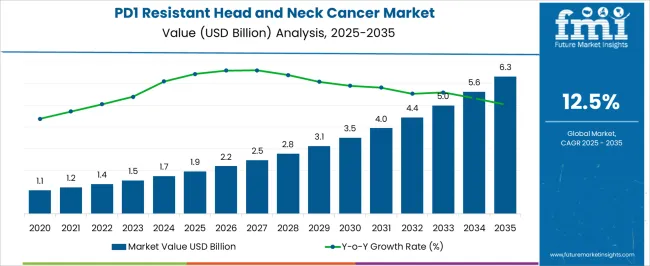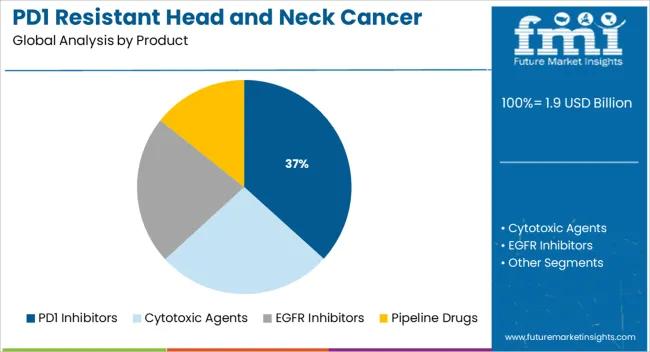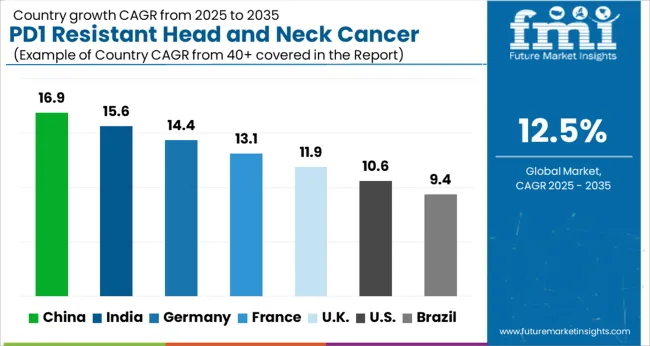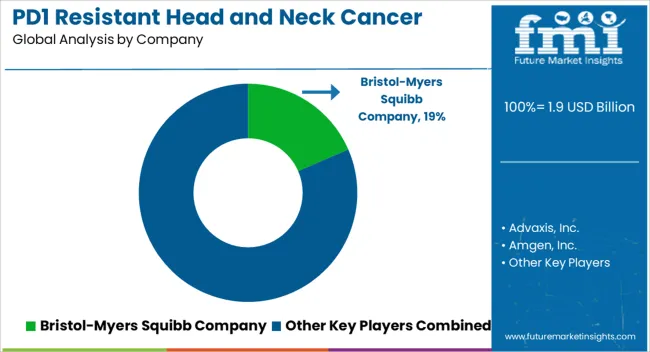The PD1 Resistant Head and Neck Cancer Market is estimated to be valued at USD 1.9 billion in 2025 and is projected to reach USD 6.3 billion by 2035, registering a compound annual growth rate (CAGR) of 12.5% over the forecast period.

| Metric | Value |
|---|---|
| PD1 Resistant Head and Neck Cancer Market Estimated Value in (2025 E) | USD 1.9 billion |
| PD1 Resistant Head and Neck Cancer Market Forecast Value in (2035 F) | USD 6.3 billion |
| Forecast CAGR (2025 to 2035) | 12.5% |
The PD1 Resistant Head and Neck Cancer market is gaining attention due to the increasing clinical challenge of immunotherapy resistance and the urgent demand for more targeted treatment approaches. Recent developments in oncology research and clinical trial disclosures have emphasized the need for advanced therapies that can overcome PD1 resistance mechanisms. A growing body of medical literature has outlined how tumor heterogeneity, immune escape pathways, and adaptive resistance continue to limit the long-term efficacy of checkpoint inhibitors in head and neck cancers.
These unmet needs have accelerated research funding, academic collaboration, and pipeline expansion from biopharmaceutical innovators. Regulatory agencies have also begun prioritizing accelerated pathways for therapies addressing resistance in high-mortality cancers, which is further catalyzing commercial development.
Industry conferences and investor updates have indicated a sharp increase in strategic partnerships and biomarker-driven trials aimed at this segment As scientific understanding deepens and combination therapies evolve, the PD1 Resistant Head and Neck Cancer market is expected to exhibit strong potential for innovation-driven growth over the next decade.
The market is segmented by Product and region. By Product, the market is divided into PD1 Inhibitors, Cytotoxic Agents, EGFR Inhibitors, and Pipeline Drugs. Regionally, the market is classified into North America, Latin America, Western Europe, Eastern Europe, Balkan & Baltic Countries, Russia & Belarus, Central Asia, East Asia, South Asia & Pacific, and the Middle East & Africa.

The PD1 inhibitors segment is projected to contribute 36.7% of the PD1 Resistant Head and Neck Cancer market revenue share in 2025, securing its position as the leading product segment. This dominance has been supported by the extensive clinical use of PD1 inhibitors as first-line and second-line treatments in head and neck squamous cell carcinoma.
Despite resistance concerns, these agents continue to be used due to their established regulatory approvals, survival benefits in selected populations, and favorable safety profiles. The segment’s sustained revenue share has also been maintained by ongoing clinical investigations into combination regimens that pair PD1 inhibitors with other targeted or immune-modulating agents to counteract resistance.
Additionally, pharmaceutical manufacturers have emphasized the continued relevance of PD1 inhibitors as part of multi-modal treatment strategies, as noted in investor briefings and oncology conference presentations Broader access in developed markets and inclusion in treatment guidelines have further solidified their market position despite the resistance landscape, making them integral to current therapeutic planning.
The PD1 Resistant Head and Neck Cancer Market were growing at a CAGR of 10.1% while valued at USD 1 Billion during the historical period. The rapidly growing pharmaceutical industry and the rising expenditure by the top market players in research and development and the availability of various pipeline drugs such as atezolizumab, Afatinib, and Ipilimumab are fuelling the market growth. Considering these factors HNC market is projected to reach USD 5 Billion with a CAGR of 12.5% during the forecast period.
Advances in biochemistry and Genomics to propel market growth
The advancements in non-surgical procedures and therapies such as immunotherapy and targeted therapy are supporting the adoption rate of PD1-resistant head and neck cancer drugs among patients across the globe. The availability of advanced diagnostic tools to diagnose various types of cancer and tumors is driving market growth.
The increasing awareness among the population regarding the availability of effective and innovative drugs to treat cancer coupled with rising healthcare expenditure is fuelling the PD1-resistant head and neck cancer market growth. The swiftly growing biopharmaceutical industry and the rising penetration of online pharmacies are the major factors that are anticipated to augment the growth of the market during the forecast period.
Moreover, several developmental strategies such as partnerships, new product launches, and adoption of the latest technologies impact the market positively and drive the industry’s growth. The growing expenditure by the top market players in research and development and the availability of various pipeline drugs such as atezolizumab, Afatinib, and Ipilimumab is also aiding in market expansion.
High rate of complications to restrain market expansion
Rising treatment costs, an increase in the adverse effects associated with the use of PD1 Resistant Head and Neck Cancerdrugs, high rate of complications, dearth of early cancer detection, and lack of awareness among patients and physicians about head and neck treatment are the major factors acting as restraints, and will further hinder the PD1 Resistant Head and Neck Cancerdrug market during the forecast period. Moreover, the dearth of proper healthcare facilities and oncology professionals across some developing and underdeveloped regions is also restricting market expansion.

North American PD1-resistant head and neck cancer market accounted for 46% market share in 2025. It is estimated to retain its dominance while exhibiting a CAGR of 11.1% during the forecast period. In this region, the US market is expected to gross a market value of USD 850 Million by end of the forecast period.
The presence of advanced healthcare infrastructure, robust product pipeline increased healthcare expenditure, favorable reimbursement policies, and improved access to advanced diagnostic devices are the major factors that drive the growth of the PD1 Resistant Head and Neck Cancer drugs market in the North American region.
In Asia Pacific, the market is projected to grow with the fastest CAGR of 11.5% with a market valuation to reach USD 6.3 Million by 2035. The growing geriatric population and increasing prescription of immunotherapy drugs such as Pembrolizumab (Keytruda) and Nivolumab (Opdivo) for the treatment of various types of HNC are anticipated to drive market growth in coming years. China is expected to dominate the market in this region with a market valuation of around USD 250 Million. Moreover, the market in Japan will be fuelled with a CAGR of 11%. Additionally, the Indian market will witness a CAGR of 11.2% during the forecast period.
Currently, four targeted therapies are existing in the APAC HNC market, which are Erbitux, BIOMAb EGFR, Opdivo, and Keytruda. The remainder of this market is composed of generics. Recent additions to the market have highlighted that the treatment landscape is diversifying and becoming less dependent on chemotherapy options.
With the approval of Keytruda in Australia, and Opdivo in Australia, South Korea, and Japan, there has been a rise in targeted therapy options. Additionally, avelumab (a PD-L1 inhibitor) is likely to be approved in APAC countries at the end of 2035, as it is currently undergoing Phase III trials in Japan, Australia, and South Korea.
Increasing demand for efficient drugs for the treatment of HNCs in emerging economies such as China and India, the growing pharmaceutical industry, and the rapidly increasing patient population are expected to fuel the growth of the market in Asia Pacific during the forecast period.
The increasing special drug designations and the high efficacy of EGFR inhibitors in the treatment of cancer indications e.g., lung cancer, colorectal cancer, and breast cancer will result in quicker approval during the clinical stages.
Thus, the robust prevalence of major cancer indications will be a significant factor driving the epidermal growth factor receptor inhibitors market during the forecast period.
The PD-1 inhibitors segment is projected to dominate the market owing to the increased volume of research activities, approvals, and increase in prescriptions of these drugs such as nivolumab and pembrolizumab. Furthermore, the rising adoption of pembrolizumab (KEYTRUDA), due to its proven efficiency to treat multiple FDA-Approved indications like melanoma, non–small cell lung cancer (NSCLC), head and neck squamous cell cancer (HNSCC), has also positively influenced the segment growth.
Additionally, the PD-L1 inhibitor segment is anticipated to witness the fastest CAGR during the forecast period owing to a sharp rise in the adoption of durvalumab (IMFINZI), avelumab (BAVENCIO), and others in the segment. Huge investments by the key players in the development of these products are further anticipated to fuel the segment growth over the forecast period.

Key players in the PD1 Resistant Head and Neck Cancer Market are Advaxis, Inc, Amgen, Inc., AstraZeneca plc, Boehringer Ingelheim GmbH, Bristol-Myers Squibb Company, Cel-Sci Corporation, GlaxoSmithKline plc, Incyte Corporation, Merck KGaA, Novartis AG.
Some Recent Developments in this industry are:
| Report Attribute | Details |
|---|---|
| Market Value in 2025 | USD 1.9 billion |
| Market Value in 2035 | USD 6.3 billion |
| Growth Rate | CAGR of 12.5% from 2025 to 2035 |
| Base Year for Estimation | 2025 |
| Historical Data | 2020 to 2025 |
| Forecast Period | 2025 to 2035 |
| Quantitative Units | Revenue in USD Billion and million and CAGR from 2025 to 2035 |
| Report Coverage | Revenue Forecast, Volume Forecast, Company Ranking, Competitive Landscape, Growth Factors, Trends, and Pricing Analysis |
| Segments Covered | Product, Region |
| Regions Covered | North America; Latin America; Europe; Asia Pacific; Middle East & Africa (MEA) |
| Key Countries Profiled | The USA, Canada, Brazil, Mexico, Germany, The UK, France, Spain, Russia, Italy, India, China, Japan, South Korea, Saudi Arabia, Australia, UAE, South Africa, Israel |
| Key Companies Profiled | Advaxis, Inc.; Amgen, Inc.; AstraZeneca Plc; Boehringer Ingelheim GmbH; Bristol-Myers Squibb Company; Cel-Sci Corporation; GlaxoSmithKline plc; Incyte Corporation; Merck KGaA; Novartis AG |
| Customization | Available Upon Request |
The global PD1 resistant head and neck cancer market is estimated to be valued at USD 1.9 billion in 2025.
The market size for the PD1 resistant head and neck cancer market is projected to reach USD 6.3 billion by 2035.
The PD1 resistant head and neck cancer market is expected to grow at a 12.5% CAGR between 2025 and 2035.
The key product types in PD1 resistant head and neck cancer market are PD1 inhibitors, _keytruda, _opdivo, cytotoxic agents, _antimetabolites, _antitubulins, _others - platinum agents, fluoropyrimidines, egfr inhibitors, _erbitux, _vectibix, _theracim/theraloc, pipeline drugs, _egfr inhibitors, _pdl1 inhibitors and _ctla4 inhibitors.
In terms of , segment to command 0.0% share in the PD1 resistant head and neck cancer market in 2025.






Full Research Suite comprises of:
Market outlook & trends analysis
Interviews & case studies
Strategic recommendations
Vendor profiles & capabilities analysis
5-year forecasts
8 regions and 60+ country-level data splits
Market segment data splits
12 months of continuous data updates
DELIVERED AS:
PDF EXCEL ONLINE
PD1 Non-Small Cell Lung Cancer Treatment Market - Growth & Outlook 2025 to 2035
Resistant Starch Market Analysis by Product Type, Source, End Use and Region Through 2035
Oil Resistant Packaging Market Size and Share Forecast Outlook 2025 to 2035
Competitive Landscape of Oil-Resistant Packaging Providers
Acid Resistant Pipe Market Forecast and Outlook 2025 to 2035
Fire Resistant Cable Market Size and Share Forecast Outlook 2025 to 2035
Fire Resistant Fabrics Market Size and Share Forecast Outlook 2025 to 2035
Fire-resistant Paint Market Size and Share Forecast Outlook 2025 to 2035
Slip Resistant Shoes Market Insights - Trends & Forecast 2025 to 2035
Heat Resistant Glass Market Size & Trends 2025 to 2035
Heat Resistant LED Light Market Analysis by End Use Industry, Material, and Region: Forecast for 2025 to 2035
Heat-Resistant Ceramic Tableware Market Analysis – Growth & Trends 2025 to 2035
Fire Resistant Hydraulic Fluid Market Growth – Trends & Forecast 2024-2034
Heat Resistant Polymer Market
Drug Resistant Pulmonary Tuberculosis Market
Pest Resistant Crops Market
Fuel Resistant Sealant Market
Fire Resistant Fluids Market
Water Resistant Packaging Market Size and Share Forecast Outlook 2025 to 2035
Child resistant Zipper Market Size and Share Forecast Outlook 2025 to 2035

Thank you!
You will receive an email from our Business Development Manager. Please be sure to check your SPAM/JUNK folder too.
Chat With
MaRIA